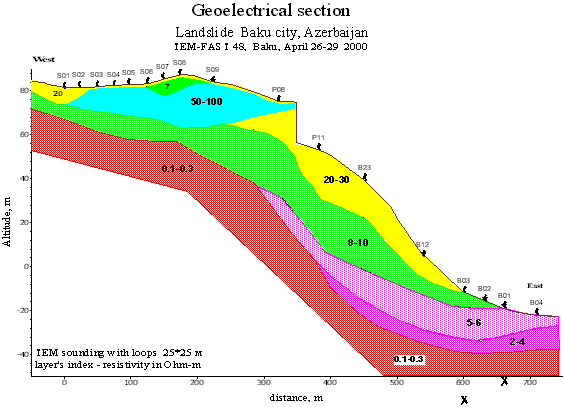


|
Geoelectrical section on a line West-East
along highway Sevastopol-Yalta (Foros area, Crimea).
The landslide's body (piquets 300-500) is combined by
terrigene rocks and has resistivity more than 20 Ohmm.
Underlying trias-jurassic argillite rocks have resistivity
less than 5 Ohmm. The volume of the slide's body is 200*400*40
cubic metres. Researches were carried out with 25m *25m antennas.
|
| TEM-FAST 48 complex has been applied for a slide
object research in Baku (Azerbaidjan, April 2000). 50 soundings with
antenna of 25m*25m size has been used when memorial complex and
the slide body investigation and 18 soundings of 50m*50m along
regional profile: Botanic garden-Memorial complex-landslide-prospect
Neftyanikov. The results of interpretation presented as geoelectrical
sections along two profiles (regional and West-East) crossing the
landslide shown in the figures 1,2. The blocks of rock in the
sections indexed by value of specific electrical resistivity
(Ohm-m) are marked with a colour: from red - for low resistance, up
to dark blue - for high.
 Assumed tectonic disturbances are shown with subvertical lines.
The body of a landslide has average resistivity 24-36 Ohm-m
and submitted by friable sand-clay formations with residual blocks of
destroyed limestone rocks.
The first slide surface coincides with a roof of clay
rocks and has resistivity from 8 up to 10 Ohm-m. The low resistivity
testifies to presence of water solutions in rocks.
Second and third slide's surface coincided with the layers of dense
clay having the resistivity 5-6 Ohm-m lay below to depth ~ 0.3 Îì-m.
In the top part of the memorial increase of the rock's resistivity up
to 100 Ohm-m which corresponds to the undefeated screening the
limestone layer open by a borehole No 1 (area of the television
center) is observed.
Bedding of the landstones is subhorizontal, while clay bottom rock
have rather steep inclination to east.
Assumed tectonic disturbances are shown with subvertical lines.
The body of a landslide has average resistivity 24-36 Ohm-m
and submitted by friable sand-clay formations with residual blocks of
destroyed limestone rocks.
The first slide surface coincides with a roof of clay
rocks and has resistivity from 8 up to 10 Ohm-m. The low resistivity
testifies to presence of water solutions in rocks.
Second and third slide's surface coincided with the layers of dense
clay having the resistivity 5-6 Ohm-m lay below to depth ~ 0.3 Îì-m.
In the top part of the memorial increase of the rock's resistivity up
to 100 Ohm-m which corresponds to the undefeated screening the
limestone layer open by a borehole No 1 (area of the television
center) is observed.
Bedding of the landstones is subhorizontal, while clay bottom rock
have rather steep inclination to east.
|
